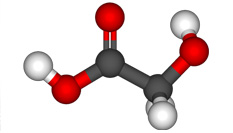







Glycolic acid molecule
Glycolic acid is an alpha-hydroxy acid derived from sugar cane (Saccharum) and it may have two skin lightening effects.
At low concentrations, glycolic acid has an epidermal discohesive effect which results in a more rapid desquamation of pigmented keratinocytes. Like retinoids, glycolic acid shortens the cell cycle so that pigment is lost more rapidly. At higher concentrations, glycolic acid results in epidermolysis.
Several studies have shown that the removal of superficial layers of epidermis with glycolic acid peels at concentrations of 30%–70% can enhance the penetration of other topical skin lighteners such as hydroquinone.
When glycolic acid is used in the treatment of post-inflammatory hyperpigmentation, it has been suggested that it should be initiated at low concentrations to avoid skin irritation and exacerbated hyperpigmentation. The use of hydroquinone both prior to and after the peel can lessen the risk of such pigmentary alterations. Also, the addition of glycolic acid to hydroquinone formulations seems to enhance its efficacy.
>
>
>
>
>
>
>
>
>
>
>
>
>
>
>
>
>
>
>
>
>
>
>
>
>
>
>
>
>
>
>
>
>
>
>
>
>
>
>
>
>
>
>
>
>
>
>
>
>
>
>
TOP 20
Hydroquinone
Monobenzyl Ether of Hydroquinone
Azelaic Acid
Kojic Acid
Arbutin
Retinoids
Mequinol
Niacinamide
Soy
Vitamin C
Corticosteroids
Licorice
Hydroxystilbene
Aloesin
Glutathione
Glycolic Acid
N Acetyl Glucosamine
Gentisic Acid
Green Tea
Melatonin
SKIN WHITENING AGENTS A-Z
a-Hydroxyacids
Aloesin
Alpha Tocopherol and Alpha Tocopherol Ferulate
Arbutin
Azelaic Acid
Centaureidin and Methylophiopogonanone B
Gallic Acid and Derivatives
Gingko
Ginseng
Glutathione
Glycolic Acid
Green Tea
Hesperidin
Hydroquinone
Hydroxycinnamic Acid and Derivatives
Hydroxystilbene
Kojic Acid
Licorice
Linoleic Acid
Magnesium Ascorbyl Phosphate
Melatonin
Mequinol
Monobenzyl Ether of Hydroquinone
Mulberry
N Acetyl Glucosamine
N-Acetyl-4-S-Cysteminylphenol
Niacinamide
Retinoids
Salicylic Acid
Soy
Vitamin C

<< Previous: Glutathione
Next: Green Tea >>